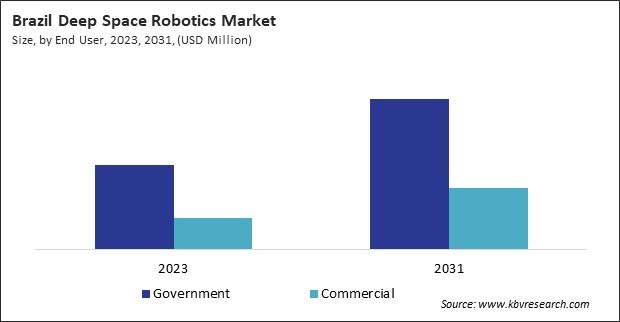The Latin America, Middle East and Africa Deep Space Robotics Market would witness market growth of 9.1% CAGR during the forecast period (2024-2031).
The Brazil market dominated the LAMEA Deep Space Robotics Market by Country in 2023, and would continue to be a dominant market till 2031; thereby, achieving a market value of $62.7 million by 2031. The Argentina market is showcasing a CAGR of 10.8% during (2024 - 2031). Additionally, The UAE market would register a CAGR of 8.6% during (2024 - 2031).

Space infrastructure assembly represents a forward-looking application where robots construct habitats, telescopes, or spacecraft directly in orbit or on planetary surfaces. This concept, often called in-space manufacturing and assembly (ISAM), promises to lower the cost and complexity of missions by reducing reliance on Earth-launched components. Robotic systems could one day build lunar bases or Martian outposts, laying the groundwork for human colonization. Additionally, the emerging field of asteroid mining relies heavily on robotics to extract valuable resources like water (for fuel) and rare metals, potentially transforming the economics of space travel.
Moreover, the adoption of deep space robotics has accelerated in recent years, driven by technological maturity and strategic priorities. Government space agencies, such as NASA, the European Space Agency (ESA), and the China National Space Administration (CNSA), have been at the forefront, integrating robotic systems into their flagship missions. NASA’s Artemis program, aimed at returning humans to the Moon, relies on robotic precursors to scout landing sites and prepare infrastructure. At the same time, China’s Chang’e lunar missions showcase advanced robotic landers and rovers. These agencies view robotics as a means to enhance mission success while minimizing risks to human life.
Brazil is emerging as an important player in space exploration with growing interest in robotic automation for deep-space missions. Brazil’s space agencies are investing in robotic satellite deployment, space station automation, and deep-space navigation systems. Collaborations with NASA, the European Space Agency (ESA), and BRICS nations are fostering innovation in robotic technologies. Developing AI-driven robotic arms and navigation systems enhances Brazil’s contributions to deep-space missions.
Free Valuable Insights: The Worldwide Deep Space Robotics Market is Projected to reach USD 2.40 Billion by 2031, at a CAGR of 7.8%
Based on End User, the market is segmented into Government and Commercial. Based on Application, the market is segmented into Satellite Servicing, Space Exploration, and Space Infrastructure Assembly. Based on Solution, the market is segmented into Services, Remotely Operated Vehicles, Remote Manipulator System, and Software. Based on countries, the market is segmented into Brazil, Argentina, UAE, Saudi Arabia, South Africa, Nigeria, and Rest of LAMEA.
By End User
By Application
By Solution
By Country
Our team of dedicated experts can provide you with attractive expansion opportunities for your business.

